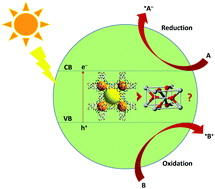Application of metal–organic frameworks as an alternative to metal oxide-based photocatalysts for the production of industrially important organic chemicals
Abstract
The present critical review reports progress over the last 10 years in the heterogeneous photocatalytic conversion to produce value-added organic products that have the potential to provide a green synthesis route for a number of industrially important chemicals. Most attention has been paid to the oxidation and reduction of organic compounds in the presence of photocatalysts. There has also been consideration of the conversion of biomass. Nowadays, titanium dioxide is the most abundant photocatalytic material due to its photoactivity under ultraviolet illumination, stability under commonly used reaction conditions and high surface area. Despite obvious achievements in the field of photocatalysis, the most significant limitation of TiO2 is its large band gap for different crystalline phases, which makes it possible to use only ultraviolet illumination to initiate photocatalytic processes. With a view to efficient solar-energy utilisation, the development of new photocatalysts, which are sensitive to visible light, is an important direction in the theory and practice of heterogeneous photocatalysis. In this regard, a special focus of this critical review is on the use of metal–organic frameworks in photocatalytic reactions because they have emerged as an interesting class of materials for applications in organic photoreactions due to their flexible tunability in composition, structure and functional properties, facilitated adsorption towards chemicals, and efficient light absorption.

- This article is part of the themed collection: Green Chemistry Reviews


 Please wait while we load your content...
Please wait while we load your content...